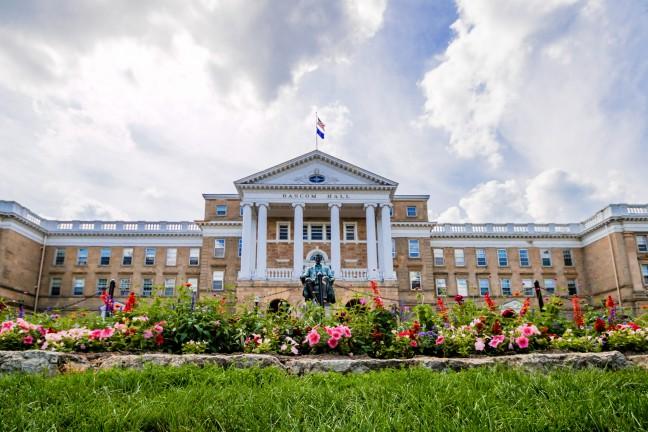From university employment to Revelry, the effects of Gov. Scott Walker’s $250 million cut to the University of Wisconsin System are widespread and impactful almost one year later.
The reveal of UW’s big budget cuts as a result of the 2015-17 biennial state budget have some faculty predicting faculty layoffs and adverse effects to student learning.
In an effort to compile factual information on just how much last summer’s state budget cuts are affecting UW System schools, UW System President Ray Cross asked each university chancellor to prepare data on how the universities are fairing without a portion of the state budget’s $250 million contribution.
$250 million cut to UW System remains as Assembly passes state budget
The documents released earlier in April detailed UW’s and other UW System schools expected effects from the cuts. According to UW’s prepared budget statement, the budget cuts affect broad ranges of areas on campus from faculty and staff positions to student employment positions.
According the documents, UW faces big risks with these budget cuts. UW’s current uncommitted funds balance would “allow [UW] to operate for less than a week.”
State cuts dive deep into UW System institutions’ pockets, according to documents
The university expects to lose 418 faculty and staff through layoffs. Most of these layoffs will occur in the College of Letters and Science, which is expected to cut 48 faculty positions and 44 staff positions. According to UW’s document, the number of offered courses is also expected to decrease as a result.
UW will also cut 6,500 hours of student employment. Research and sponsored programs are expected to cut 6,300 hours of student work. These cuts mean not only a reduction in services, but a loss of learning opportunities and student financial support.
In an email to The Badger Herald, UW spokesperson Greg Bump, said some of the positions that are going to be cut are currently vacant positions.
Though the College of Letters and Science will see most of the cuts to faculty and staff positions, this, however, is due in part to it being UW’s largest college, Bump said.
These expected cuts come during a time of tension, as many faculty worry about the recent changes to tenure that were approved of the Board of Regents back in March.
UW System to see changes to tenure policy after Board of Regents vote
Due to these changes, some UW faculty have planned to take a vote of “no confidence” to Cross — calling for better leadership of the UW System.
‘Trouble with Tenure’ report considers necessity of tenure, lack of data on post-tenure reviews
In the midst of these cuts, UW shelled out nearly $9 million to retain top faculty from leaving to other universities. Despite offering more money, several faculty opted to leave UW for opportunities elsewhere.
Because of the general difficulties in hiring, the Office of Undergraduate Advising, according to the document, expect some student’s graduation rates may decrease as result as well due to students being unable to receive mentoring for classes and support, Associate Vice Provost for Academic Advising, Wren Singer, said.
The lack of funds also means colleges like the College of Engineering are unable to fill much-needed advising positions. Already, the College of Engineering has 17 advisors serving its 6,000 students — about five advisors short of the minimum it needs to serve its students effectively, Singer said.
Without additional advisors, current advisors are forced to work harder than before to ensure students are seen. As a result, Singer said UW has difficulty retaining advisors because they become “burnt out” from the heavy work load.
“When we have goals as a campus — goals of graduating more students graduating students more quickly and retaining students — there are trade offs when some things are not funded and they don’t work as well,” Singer said.
Less advisors means less time for students who need more mentorship, she said. Students from lower socioeconomic or more diverse backgrounds for example may be at a greater disadvantage because they often rely on the support advisors provide more than other students.
The national recommendation for the ratio of students to advisors is 300 students to one advisor. While UW has worked hard to maintain a ratio close to that recommendation, Singer said UW’s ratio is still not close.
Though the university has predicted how the budget cuts will impact certain areas of education, it has yet to pinpoint how exactly the cuts will impact the quality of teaching, learning and research at UW.
The “chaos and uncertainty” will really begin as UW starts toward the 2017-19 biennial budget and the UW System’s biennial budget, Wisconsin Center of the Advancement of Postsecondary Education Director and Associate Researcher, Noel Radomski, said.
Though Radomski said the results of this budget won’t be available until after July 2017, each university, their colleges and UW Extension will have to determine the amount of cuts and where they will come from.
If history is anything to go off of, Radomski said he speculates staff will begin to receive layoff notices and changes to course availabilities and sections in spring 2018. He said this is when the results of Walker’s initial executive budget will begin to be seen.
But Radomski said he believes it will be more than UW hurting from these cuts, but UW System schools. Unlike UW, other UW System schools do not have reserves and funding from programs like the UW Foundation and the Wisconsin Alumni Research Foundation.
In addition, Radomski said UW will generate a significant amount of new tuition due to the increases of non-resident domestic and the non-resident international tuition rates.
“Unfortunately, things will get much worse at the non-UW-Madison institutions in the UW System,” he said. “We are already seeing it, or in Madison we are not seeing it.”


















